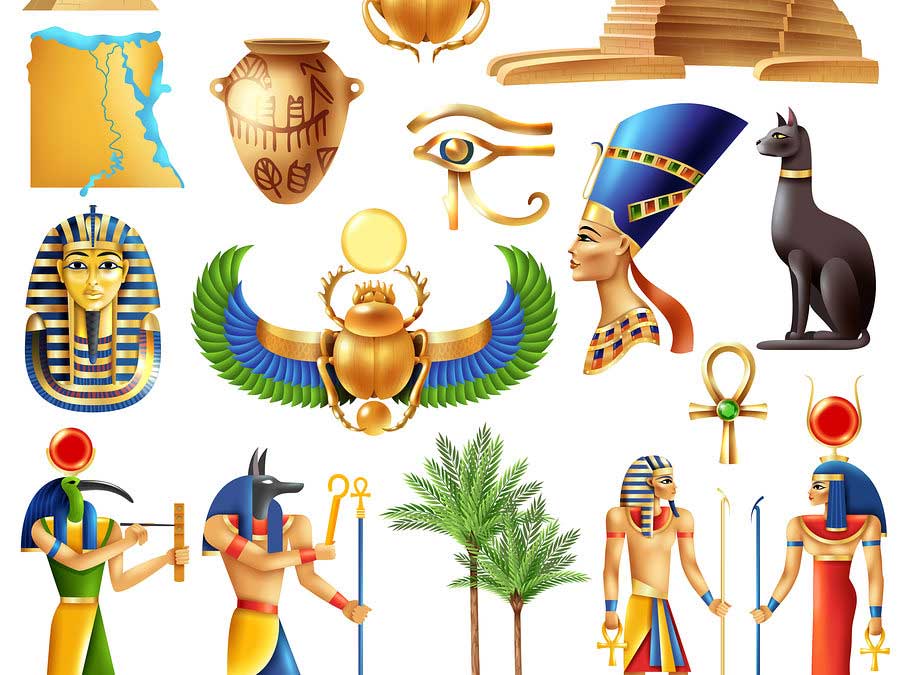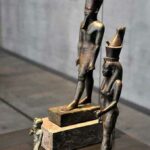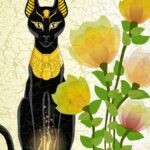Ancient Egyptian symbols were a fusion between their ideas and their existence that took the shape of what the ancient Egyptians desired who were very creative and organized as each symbol had its own shape and meaning that came from their own lives. Each symbol played a role in their lives and often was related to ideas like life, death, birth, regeneration, power, love, protection, healing, weakness, hatred, and more. These ancient Egyptian Symbols played a vital role in passing the culture from one generation to another, as they were written on temple walls & obelisks and used in magical and religious rituals for both the living and the dead. The Egyptian symbols were depicted in the form of hieroglyphs and treated as “The Words of Gods” which was used to document the most important events in ancient Egyptian History.
Religion in ancient Egypt was fully integrated into the people’s daily lives. The gods were present at one’s birth, throughout one’s life, in the transition from earthly life to the eternal, and continued their care for the soul in the afterlife of the Field of Reeds. The spiritual world was ever present in the physical world and this understanding was symbolized through images in art, architecture, in amulets, statuary, and the objects used by nobility and clergy in the performance of their duties.
Symbols in a largely illiterate society serve the vital purpose of relaying the most important values of the culture to the people generation after generation, and so it was in ancient Egypt. The peasant farmer would not have been able to read the literature, poetry, or hymns which told the stories of his gods, kings, and history but could look at an obelisk or a relief on a temple wall and read them there through the symbols used.
The Egyptian mythology includes great stories to discover, you can buy and witness these memorable symbols by booking unforgettable Egypt tours packages or enjoying incredible Nile River cruise to observe the majestic temples of Egyptian pharaohs and explore the myths of gods and goddess.
What Did Ancient Egyptian Symbols Mean?
Each one of the ancient Egyptian symbols was a reflection of the power and wisdom of the gods and played a role in their lives and often was related to ideas like Life, Death, Birth, Regeneration, Truth, Faith, Fertility, Power, Wealth, Luck, Pharaonic symbols were numerous in the life of ancient Egyptians and varied in their symbols, rituals, and use. Also, the Egyptian creativity in the manufacture and symbol and reliance on them clearly in various aspects of his life and areas, whether social, religious, cultural or recreational and because these symbols have important meanings in the history of the Pharaohs had to be addressed.
Ancient Pharaonic symbols were a fusion between their ideas and their existence that took the shape of what the ancient Egyptians desired who were very creative and organized as each symbol had its own shape and meaning that came from their own lives. Each symbol played a role in their lives and often was related to ideas like life, death, birth, regeneration, power, love, protection, healing, weakness, hatred, and more. These symbols were referred to as the words of the gods and played a vital role in passing the culture and the beliefs of the ancient Egyptians from one generation to another.
The three most important symbols, often appearing in all manner of Egyptian artwork from amulets to architecture, were the ankh, the djed, and the was scepter. These were frequently combined in inscriptions and often appear on sarcophagi together in a group or separately. In the case of each of these, the form represents the eternal value of the concept: the ankh represented life; the djed stability; the was power.
Here are some of the most famous Egyptian symbols with their meanings:
1- The Eye of Horus
The Eye of Horus is an ancient Egyptian symbol that represents protection, sacrifice, healing, regeneration, and royal power. It is also used to protect both the living and the dead from evil forces.
During the fight between Horus and Set, both the gods sustained heavy injuries; Horus’s eye was ripped out and Set lost a testicle. The latter is used to indicate why the desert, which is represented by Set, is barren.
According to one version, Set tore out Horus’s eye and — like he did to Horus’s father — ripped his eye in six parts and threw them away.
In another version, it was Horus himself who tore out his eye to bring his father back to life. This illustrates why the Eye of Horus is considered to be a symbol of sacrifice.
After Horus lost his eye, it was restored magically. Some versions claim that Hathor, Goddess of the sky, fertility, beauty, and women, reconstructed his eye. Hathor is also believed to be Horus’s consorts. Others state that it was Thoth, the God of wisdom, magic, and moon, who gave Horus back his eye.
At this point, the Eye was called “Wadjet,” “Wedjat,” “Udjat” and “Wedjoyet” which translated to “whole and healthy.” Since it is widely believed that it was Horus’s left eye which was gouged out, it represented the waxing and waning of the moon.
The days in which there is no moon in the sky illustrates the time when Horus’s eye was ripped out, before being restored every lunar month.
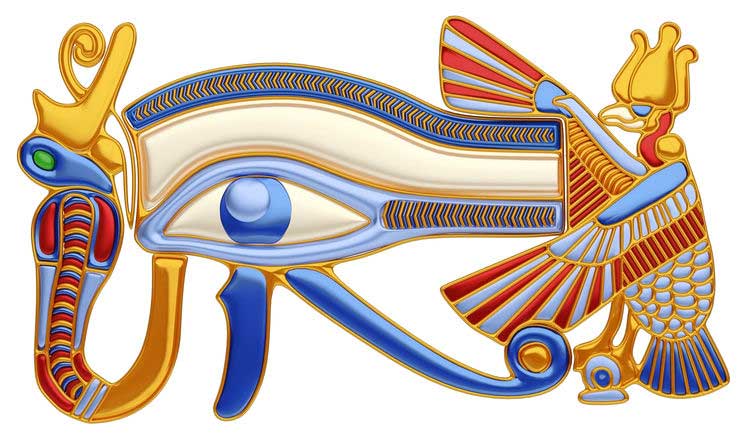
Is the Eye of Horus related to the brain?
The Eye of Horus is not just magical; it also corresponds to the neuroanatomical features of humans. If the Eye is superimposed over the median cut of the brain, each of its six parts relate to six essential areas of the human brain, i.e. the corpus callosum, the interthalamic adhesion, anterior transverse temporal lobe and posterior transverse temporal lobe, the olfactory trigone, somatosensory pathway, and the taste pathway.
Is the Eye of Horus the Third Eye?
The Eye of Horus has been known by many names and is closely associated with the “Third Eye,” “the Eye of the Mind,” and the “Eye of Truth and Insight.”
Therefore, Egyptologists also believe that the Eye of Horus may be the precursor of the other significant eyes that have appeared in other cultures. Most notably, Shiva, one of the gods in Hindu theology, is always represented with a third eye on his forehead which represents the crown chakra and provides perception beyond simple sight.
In Buddhism, the Buddha is referred to as the “Eye of Truth” or the “Eye of the World.”
[ Read a full article about The Eye of Horus]
2- The Eye of Ra
The Eye of Ra or Eye of Re is a being in ancient Egyptian mythology that functions as a feminine counterpart to the sun god Ra and a violent force that subdues his enemies. The eye is an extension of Ra’s power, equated with the disk of the sun, but it also behaves as an independent goddess. This goddess can be equated with several particular deities, including Hathor, Sekhmet, Bastet, Wadjet, and Mut. The eye goddess acts as mother, sibling, consort, and daughter of the sun god. She is his partner in the creative cycle in which he begets the renewed form of himself that is born at dawn. The eye’s violent aspect defends Ra against the agents of disorder that threaten his rule. This dangerous aspect of the eye goddess is often represented by a lioness or by the uraeus, or cobra, a symbol of protection and royal authority. The Eye of Ra is similar to the Eye of Horus, which belongs to a different god, Horus, but represents many of the same concepts. The disastrous effects when the eye goddess rampages out of control and the efforts of the gods to return her to a benign state are a prominent motif in Egyptian mythology.
There are different myths about the origin of the Eye of Ra symbol. However, most experts believe that the symbol was actually the right eye of Horus and became known as the Eye of Ra in ancient times. The two symbols mostly represented the same concepts. That said, according to different myths, the Eye of Ra symbol was identified as the personification of many goddesses in Egyptian mythology, such as Wadjet, Hathor, Mut, Sekhmet, and Bastet.
Ra or also known as Re is the sun god in Egyptian mythology. Therefore, the Eye of Ra symbolizes the sun.
The Eye of Ra was involved in many areas of ancient Egyptian religion, including in the cults of the many goddesses who are equated with it. Its life-giving power was celebrated in temple rituals, and its dangerous aspect was invoked in the protection of the pharaoh, of sacred places, and of ordinary people and their homes.
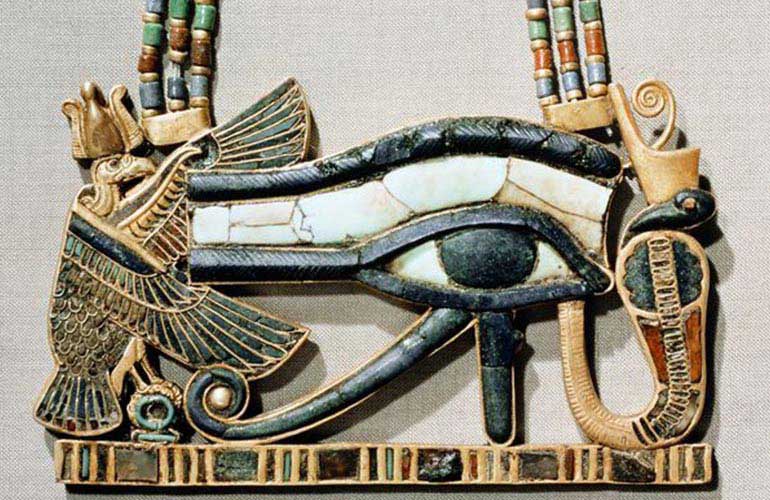

What is the difference between the Eye of Ra and Eye of Horus?
The Eye of Ra is similar to the Eye of Horus and represents many of the same concepts.
Eye of Ra (Right Eye)
• Related to the Sun
• Symbol of protection
• Symbol of power
• Symbol of good luck
• Represents fertility, birth and femininity
• Represents aggression and danger when provoked
Eye of Horus (Left Eye)
• Related to the Moon
• Symbol of protection
• Symbol of power
• Symbol of wellbeing and health
• Symbol of sacrifice
• Used to ward off evil
• Used as a measuring system
The ancient Egyptians often called the sun and the moon the “eyes” of gods. For instance, the right eye of Horus was referred to as the sun, while his left eye was referred to as the moon.
However, in Egyptian mythology, many concepts are fluid, so at times, Egyptians called the moon the Eye of Horus, and called the sun, the Eye of Ra.
Like the sun, the Eye of Ra is the source of light and heat and is closely linked to the element of fire. It is also associated with the red light of the dawn and the morning star that signals the arrival of the sun.
Since the sun brings the new day, so the life-giving powers of the Eye of Ra were celebrated in many rituals. Conversely, its violent aspects were invoked while protecting the pharaoh, holy places, or the common people.
Both The Eye of Horus and The Eye of Ra offer great protection, however, it is the way this protection is demonstrated that separates the two. It is also generally believed that while the left eye symbolizes Horus, the right eye symbolizes Ra.
3- Ankh
The Egyptian cross, also known as Ankh, was originally an Egyptian hieroglyph used to represent the word “life”. By extension, this cross became primarily a symbol of life.
The ankh is one of the most common ancient Egyptian hieroglyphs, used in art, writing and decorations. It represents the word “life” and life itself, as well as heaven, male & female, the morning sun, and the earth. It was often used to express the desire for someone to live – e.g. “may you live and be well”, and was held as a key to eternal life. Its beautiful shape was emulated by neighbouring cultures, who adapted it in many different ways, such as by using it as a variation of the Christian cross. Nowadays it is often associated with the Goth subculture.
The Ankh is considered to be an ancient Egyptian symbol for Life, Protection, Faith, Energy, transformation, Light, and fertility. The Ankh can also refer to the concepts and symbols of sexual union between the two opposite sexes and fertility due to its connection to the goddess Isis. The Ankh is the clearest and simple example of the ancient Egyptian understanding of immortality, future life, reproduction, and overall the concept of the cycle of life.
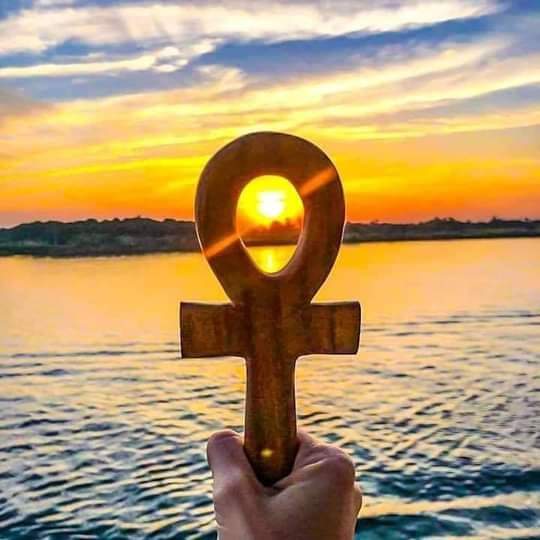
What the Ankh represent?
The ankh represents the union of man and woman and symbolizes the creation of life through this union. According to one of the theories about the origin of the ankh, the symbol could be the combination of the male and female symbols representing Osiris and Isis, the cross and the oval, respectively. It was believed that the union of Osiris and Isis flooded the Nile every year and gave life to Egypt by providing fertility. That is why the symbol is also known as “the Key of the Nile” and why it is considered to represent the union of heaven and earth.
The origin of the Ankh symbol
The origin of the Ankh symbol is not entirely well known, but it can be seen in the Egyptian hieroglyphic writing. The Ankh was taken by the Hebrews from the Egyptians and was introduced to the language by Moses, who was instructed in the wisdom of the priests of Egypt along with many other mystical words.
4- Lotus
Lotus symbol
The ancient Egyptians cultivated the white lotus in ponds and marshes.
This flower often appears in ancient Egyptian decorations. They believed that the lotus flower gave them strength and power; remains of the flower have been found in the burial tomb of Ramesses II. Egyptian tomb paintings from around 1500 BC provide some of the earliest physical evidence of ornamental horticulture and landscape design; they depict lotus ponds surrounded by symmetrical rows of acacias and palms. In Egyptian mythology Horus was occasionally shown in art as a naked boy with a finger in his mouth sitting on a lotus with his mother. The lotus was one of the two earliest Egyptian capitals motifs, the topmost members of a column. At that time, the motifs of importance are those based on the lotus and papyrus plants respectively, and these, with the palm tree capital, were the chief types employed by the Egyptians, until under the Ptolemies in the 3rd to 1st centuries BC, various other river plants were also employed, and the conventional lotus capital went through various modifications. Women often wore amulets during childbirth, which depicted Heqet as a frog, sitting in a lotus.

5- Cartouche
In Egyptian hieroglyphs, a cartouche is an oval with a line at one end at right angles to the oval, indicating that the text enclosed is a royal name. The first examples of the cartouche are associated with pharaohs at the end of the Third Dynasty, but the feature did not come into common use until the beginning of the Fourth Dynasty under Pharaoh Sneferu. While the cartouche is usually vertical with a horizontal line, if it makes the name fit better it can be horizontal, with a vertical line at the end (in the direction of reading). The ancient Egyptian word for cartouche was shenu, and the cartouche was essentially an expanded shen ring. Demotic script reduced the cartouche to a pair of brackets and a vertical line.
A cartouche is an ancient Egyptian hieroglyphic nameplate The cartouche has an obvious link and symbolism to the sun the cartouche Symbolizes of protection against evil spirits both in this life and the afterlife, The symbol, which had the shape of a circle originally also shaped like an oval with a horizontal bar, was sometimes used as a cartouche. This kind of use aimed to represent divine protection also the cartouche closely linked in appearance to the ouroboros serpent biting its own tail.
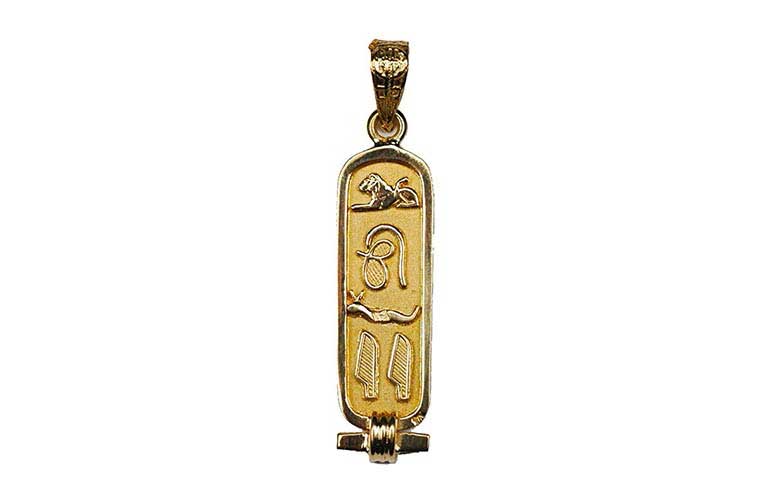
6- Djed
Djed symbol
The djed is an ancient Egyptian symbol for stability which features prominently in Egyptian art and architecture throughout the country’s history. `Stability’ should be understood to mean not only a firm footing but immutability and permanance. The symbol is a column with a broad base which narrows as it rises to a capital and is crossed by four parallel lines. The column and the lines are sometimes brightly painted and other times monochrome. The djed first appears in the Predynastic Period in Egypt (c. 6000-3150 BCE) and continues through the Ptolemaic Dynasty (323-30 BCE), the last dynasty to rule Egypt before it became a province of the Roman Empire.
The djed is often overlooked in Egyptian art, and especially in architecture, simply because it is so ubiquitous; the djed is featured on pillars, tomb walls, architraves (the main beam which rests on pillars), palace walls, sheets of painted papyrus, and especially sarcophagi. Once one is aware of the djed and its importance to ancient Egyptian culture it is impossible to miss. It is a potent symbol associated with the god Osiris and his return from the dead. The symbol has been interpreted to represent different objects such as the god Osiris’ backbone, the tamarisk tree which enclosed the god, four pillars rising one behind another, and a fertility pole raised at festivals. `Stability’, however, seems to have been its prime meaning and the one which the ancient Egyptians attached the greatest importance to.
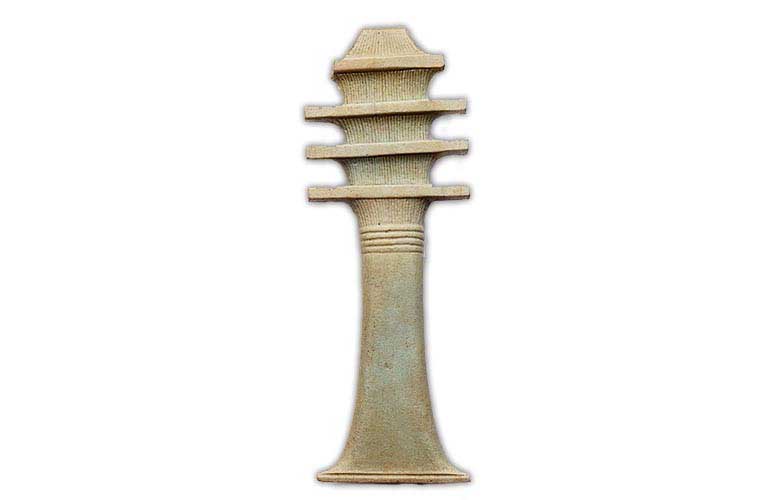
Djed symbol meaning and origin
The precise origin of the djed is unknown but it was associated with the god Ptah, an early creator god in the Predynastic Period whose attributes were later assumed by the deities Atum and Osiris. According to historian Clare Gibson, the djed was an early phonogram which could also act as a pictogram or ideogram. A phonogram is a symbol representing a sound and a pictogram a symbol for a specific word or phrase while an ideogram is a symbol of a thing itself without reference to words or sounds (such as numerals where one recognizes the symbol 10 as representing a certain quantity). The djed symbolized the spoken word-concept for stability, was the written word for stability, and stood for the concept itself.
7- Scarab
The scarab is one of the most frequently seen symbols in Egyptian culture, mythology, and hieroglyphics. That’s hardly surprising given how common the scarab “dung” beetles were and still are in the region.
In ancient Egyptian religion, Scarab was an important symbol in the form of the dung beetle which lays its eggs in dung balls fashioned through rolling. This beetle was associated with the divine manifestation of the early morning sun, Khepri, whose name was written with the scarab hieroglyph and who was believed to roll the disk of the morning sun over the eastern horizon at daybreak. Since the scarab hieroglyph, Kheper, refers variously to the ideas of existence, manifestation, development, growth, and effectiveness, the beetle itself was a favourite form used for amulets in all periods of Egyptian history.
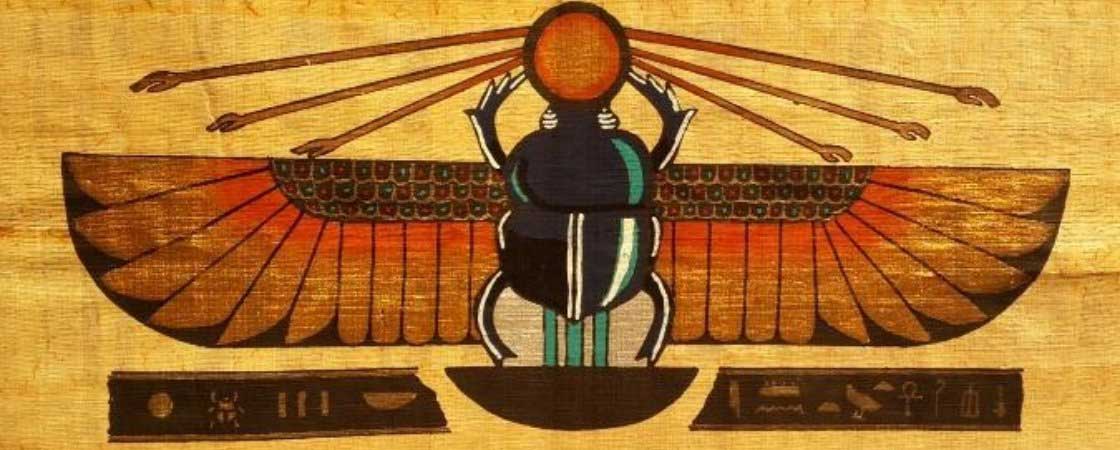
What the Scarab Symbolize?
As the ancient Egyptians believed in life after death, scarabs were often used to symbolize that concept as well as the simply day-to-day cycle people went through. The most famous “scarab god” was Khepri, as the one who rolled the sun into the sky, but the beetles weren’t exclusively used to represent just this deity. They were more of a universal symbol that was widely used in almost any context.
Probably the most famous historical piece of art related to the Egyptian scarab was the golden scarab of Nefertiti discovered in the Uluburun shipwreck, dated to the 14th century BCE. Amenhotep III was also famous for having commemorative scarabs made as royal gifts or for propaganda.
8- The Was Sceptre
The Was Sceptre is an ancient Egyptian symbol for Power, Authority, Dominion, plus wealth, and happiness. In the hands of Ptah, the Was scepter was combined the Ankh and the Djed to for the sculptor of the earth.
The was sceptre is a symbol that appeared often in relics, art, and hieroglyphics associated with the ancient Egyptian religion. It appears as a stylized animal head at the top of a long, straight staff with a forked end.
Was sceptres were used as symbols of power or dominion, and were associated with ancient Egyptian deities such as Set or Anubis as well as with the pharaoh. Was sceptres also represent the Set animal. In later use, it was a symbol of control over the force of chaos that Set represented.
In a funerary context the was sceptre was responsible for the well-being of the deceased, and was thus sometimes included in the tomb equipment or in the decoration of the tomb or coffin. The sceptre is also considered an amulet. The Egyptians perceived the sky as being supported on four pillars, which could have the shape of the was. This sceptre was also the symbol of the fourth Upper Egyptian nome, the nome of Thebes (called wꜣst in Egyptian).
Was sceptres were depicted as being carried by gods, pharaohs, and priests. They commonly occur in paintings, drawings, and carvings of gods, and often parallel with emblems such as the ankh and the djed-pillar. Remnants of real was sceptres have been found. They are constructed of faience or wood, where the head and forked tail of the Set animal are visible. The earliest examples date to the First Dynasty.
The ‘Was Sceptre’ was one of the most important Egyptian Symbols Was scepter was the symbol of power in ancient Egyptian culture also represented the dominion of gods and According to what the ancient Egyptians believe it also ensured the continuance of a king’s prosperity, The ‘Was Sceptre’ has a straight shaft, a crooked handle in the shape of an animal head and a forked base The crooked top of the staff
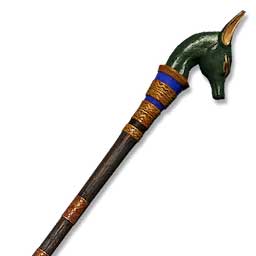
9- Ouroboros
Ouroboros in Egyptian mythology was one of the symbols of the sun, as it represented the journeys of Aten, the solar disk in Egyptian mythology. In addition to that, Ouroboros represented rebirth, recreation of life and perpetuity.
Ouroboros, emblematic serpent of ancient Egypt and Greece represented with its tail in its mouth, continually devouring itself and being reborn from itself. A gnostic and alchemical symbol, Ouroboros expresses the unity of all things, material and spiritual, which never disappear but perpetually change form in an eternal cycle of destruction and re-creation.
In the Book of the Dead, the image of “the serpent eating itself or the serpent eating its tail” is closely associated with Atum, the first god to be born from the chaotic waters of the Nun (the primordial water from which all creation began in the first place) who was born from these waters in the form of a serpent that was renewed every morning.
The Egyptians passed on the symbol of the Ouroboros to the Phoenicians who eventually passed it on to Greek culture. The name ouroboros was given to the symbol by the Greeks.
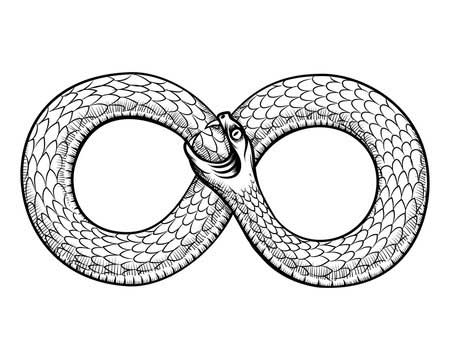
10- The Ba
Ba is an Egyptian decorated bird, symbolic of personality and perseverance. As legend goes, Ba would complete tasks during the day before faithfully returning home at night. The Ba was seen as the part of the person’s soul that could travel between the living and the dead. The Egyptians believed that a Ba symbol could preserve a person’s looks after death. Tattoo ideas for Ba include incorporating the bird into an Egyptian temple scene or using it as the centerpiece of a sleeve.

What the Ba represent?
The Ba is an Ancient Egyptian Symbol of The Personality, the Spiritual manifestation that leaves the body at the point the Death which is an integral part of the individuality of every human being. It is showcased as a falcon or a bird with the head of a human. The Ba is is the roaming Physical essence of the soul and the emblem of the soul ascension after death. Some believe that that Ba influenced the creation of the Mummification Process so the Ba Spirit can return to the body at night. The Ba has the power to tow the Barque of the sun and travel every night in the underworld.
Ba is an Ancient Egyptian Symbol of the soul, rebirth, Divinity, Death, Life, and Afterlife. It is the roaming Physical essence of the soul. In the Ancient Egyptian religion, the Bas was seen as a bird with a human head that would unite with the Ka and bring the mummy to life.

